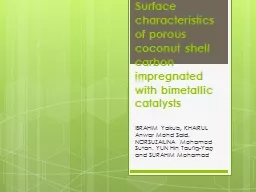

IBRAHIM Yakub KHAIRUL Anwar Mohd Said NORSUZAILINA Mohamed Sutan YUN Hin Taufiq Yap and SURAHIM Mohamad Introduction Nitrogen Oxides NOx from stationary sources such as incinerators and power plants are toxic environmental pollutants ID: 313921
Download Presentation The PPT/PDF document "Surface characteristics of porous coconu..." is the property of its rightful owner. Permission is granted to download and print the materials on this web site for personal, non-commercial use only, and to display it on your personal computer provided you do not modify the materials and that you retain all copyright notices contained in the materials. By downloading content from our website, you accept the terms of this agreement.
Slide1
Surface characteristics of porous coconut shell carbon impregnated with bimetallic catalysts
IBRAHIM
Yakub
,
KHAIRUL Anwar
Mohd
Said,
NORSUZAILINA Mohamed
Sutan
,
YUN
Hin
Taufiq
-Yap
and SURAHIM
Mohamad
Slide2
Introduction
Nitrogen Oxides (NOx) from stationary sources such as incinerators and power plants are toxic environmental pollutants
Selective catalytic reduction (SCR) is currently the most widely used method to reduce NOx emissions in power plants and automobile
application
Much
attention has been paid to the development of low-temperature SCR catalysts, capable of undergoing a reaction under 300
o
C because;
Suitable for relatively
cheap and readily available
precursors such
as activated carbon
the exhaust contains
less particulate
matter that may cause catalyst deactivation and poisoning, as well as other pollutants such as SO
2
and
Arsenic
carbon fiber and activated
coke showed high
NOx removal efficiency at low temperatures (100 – 250
o
C) Slide3
Objective
To determine the potential of an SCR catalyst derived from coconut shell carbon in low-temperature SCR system using;
surface
chemistry
characterization
morphology observationSlide4
MethodologySlide5
Results & Discussion
Surface Area
The
BET surface area of the catalyst is larger than the carbon mainly due to the increase in external surface area after synthesis process.
This improvement is beneficial as more available sites can be introduced for the SCR reaction to take place.
Properties
CSC
Cu-Mn/CSC
BET surface area (m
2
/g)
819.2
903.3
External surface area (m
2
/g)
35.64
187.8
Internal surface area (m
2
/g)
783.5
715.5
Micro pore volume (cc/g)
39.21
35.05
Average pore diameter (Ǻ)
21.28
26.12Slide6
N2 adsorption-desorption
isotherm
BET adsorption isotherms for both samples are similar, that is Type
IV
hysteresis loop for CSC is Type H3 while for Cu-Mn/CSC is Type
H4
the calcination process had resulted in a more uniform distribution of slit-shape pores formed by aggregates of plate-like particles
Slide7
Surface acidity
From the 4,599 μmol NH
3
desorbed, almost 50% was allowed to detach from the basic functional groups at 674
o
C while the other half at
871
o
C
This implies that ammonia was strongly adsorbed by the catalyst, either at the surface or at the metal oxides where it will react with NOx to form
nitrogenSlide8
Surface basicity
There were 6,341 μmol CO
2
desorbed form each gram of the catalyst
Most of the CO
2
evolved at high temperature between 600 to 900
o
C which suggests the presence of lactonesSlide9
Catalyst reducibility
Copper and manganese oxides were reduced at temperature around 246 and 574
o
C with at least 80% of the reduction occurred at the higher temperatureSlide10
Conclusion
Coconut shell carbon utilized as SCR catalyst support showed suitable surface characteristics to be applied in low-temperature SCR
system
N
2
adsorption-and-desorption test
showed
increase in surface area and change in hysteresis loop from Type H3 to Type
H4
H2
-TPR showed the presence of the bimetallic catalysts which were both
reduced
CO2-TPD and NH3-TPD indicated higher presence of acidic functional groups on the catalyst that is suitable for ammonia (reductant in SCR) adsorptionSlide11
Acknowledgement
The
authors acknowledge the Ministry of Education Malaysia for the fund RAGS/c(7)/940/2012(41) as well as
Universiti
Malaysia Sarawak and
Universiti
Putra Malaysia for the research facilities.Slide12
References
[1] S. Singh, M.A.
Nahil
, X. Sun, C. Wu, J. Chen, B. Shen, P.T. Williams, Novel application of cotton stalk as a waste derived catalyst in the low temperature SCR-
deNOx
process, Fuel 105 (2013) 585-594.
[2] J. Yang, H. Ma, Y. Yamamoto, J. Yu, G. Xu, Z. Zhang, Y. Suzuki, SCR catalyst coated on low-cost monolith support for flue gas denitrification of industrial furnaces, Chemical Eng. J. 230 (2013) 513-521.
[3] T.
Karanfil
, J.E.
Kilduff
, Role of Granular activated carbon surface chemistry on the adsorption of organic compounds. 1. Priority Pollutants, Environ. Sci. & Tech. 33 (1999) 3217-3224.
[4] Kusakabe, et al., Effect of SO
2
on coke catalyzed reduction of NO by ammonia, Vol. 69, Elsevier,
Kidlington
, 1990.
[5]
J
.
Pasel
, P.
Kabner
, B.
Montanari
, M.
Gazzano
, A.
Vaccari
, W.
Makowski
, et al., Transition metal oxides supported on active carbons as low temperature catalyst for the selective catalytic reduction (SCR) of NO with NH
3
, Appl. Catalysis B: Environ. 18 (998) 199-213.
[6]
Q
. Li, H. Yang, Z. Ma, X. Zhang, Selective catalytic reduction of NO with NH
3
over
CuOx
-carbonaceous materials, Catalysis
Commun
. 17 (2012) 8-12.
[7]
A
.
Boyano
, M.J. Lazaro, C.
Cristiani
, F.J. Maldonado-
Hodar
, P.
Forzatti
, R.
Moliner
, A comparative study of V
2
O
5
/AC and V
2
O
5
/Al
2
O
3
catalysts for the selective catalytic reduction of NO by NH
3
, Chemical Eng. J. 149 (2009) 173-82.
[8] J. Muniz, G.
Marban
, A.B. Fuertes, Low temperature selective catalytic reduction of NO over
polyarylamide
-based carbon
fibres
, Appl. Catalysis B: Environ. 23 (1999) 25-35.